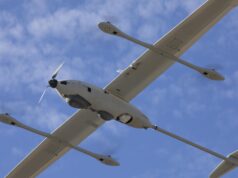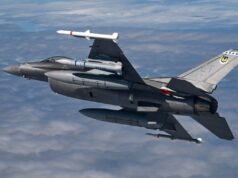RAF A400M Atlas, the RAF’s newest transport aircraft has achieved a new milestone, gaining full aeromedical evacuation capability for high dependency and highly infectious patients.
According to the RAF, the delivery of this airborne medical capability represents another important step forward for the Atlas programme, which is delivering vital air transport solutions for the RAF.
The A400M can carry up to 66 low to medium dependency stretcher patients or 4 high dependency stretcher patients. The Critical Care Air Support Team (CCAST) based at RAF Brize Norton provides care equivalent to that found in an NHS Intensive Care Unit including intubation and ventilation.

“One of the benefits of the Atlas is that it can operate at sea level cabin altitude for critical injuries such as lung punctures and head trauma which is a limitation of our other aircraft.” – Air Commodore Claire Walton, Air Officer Medical Operations
The Atlas also supports the Air Transportable Isolator (ATI) which is a secure high-tech plastic bubble that allows patients with high consequence infectious diseases to be transported safely without infecting others. Once landed, the ATI patient is transported to the hospital (usually the Royal Free Hospital in London) by ambulance.

“The RAF maintains the ATI on behalf of the British Government. We have more experience than any other military in the world in using this system to move patients with infectious diseases and have used it to safely transport patients with Ebola from Sierra Leone back to the UK.” – Wing Commander Linfield
The full aeromedical evacuation capability of the A400M including CCAST and ATI represents a major landmark for the programme and the development of a world-class air transport capability for the RAF.
Despite this, Airbus has recently said that buyers had agreed to work on contractual changes, including a ‘new roadmap’ for development and completion of capabilities for the A400M, in simple terms less promised capabilities are to be integrated and delivery is to be slowed.
Airbus had already taken a writedown of 1.2 billion euros one year ago after the A400M suffered engine gearbox problems and delays in fitting parachuting capacity and advanced defences. It is understood that Airbus has been urging partner nations to cap its exposure to fines caused by technical delays to the programme.
We understand that Airbus is expecting the rate of production to fall from 19 per year to 15 in 2018 and 11 in 2019 in order to help to extend the life of the programme and increase the chance of export sales.
“An increase to the Loss Making Contract provision on the programme, which may be material, is under assessment for the Full Year 2017 results which will be disclosed on 15 February 2018,” Airbus said in a statement.
“Since its inception in 2003, this programme has suffered not only from a number of operational issues but, more importantly, under a flawed contractual set-up and insufficient budget which resulted in significant losses for Airbus,” Airbus Chief Executive Tom Enders said in the statement.
“We have a good chance to stop or at least reduce the bleeding now and deliver the capabilities our customers need,” he added.













[…] post A400M Atlas gains full aeromedical capability appeared first on UK Defence […]
A lot of drivel has been written about this programme. What often does not get mentioned when criticism is levelled at the aircraft is that even if it is late in delivering certain contracted capabilities, 1. Airbus is totally committed to achieving these capabilities even though for the company it represents a loss-making contract. All it wants is more time and for its liabilities to be capped. What it cannot do is continue to spend money putting things right while simultaneously accumulating higher and higher liquidated damages for late deliveries. 2. The performance achieved by the aircraft and many of its systems even at this stage is already far in excess of anything else the RAF has in existence. 3. In many areas the aircraft already significantly exceeds the capabilities specified in the contract. I’m glad to see yet another major milestone has been met, especially one that is so critical for getting our boys and girls back from war zones and for humanitarian relief. This aircraft is going to be a world beater. The RAF has already received 18 of its 22 aircraft and together with the French, is using it throughout the world.
I think it’s important that contractors are held to the flame over legally binding contracts. I would rather Airbus shareholders miss out on some dividend payments than European tax payers pick up the extra expense!
After all, Airbus signed the contract. As a business owner, if I drop the ball, its tough luck. I can’t say ” terribly sorry, I miss judged the contract and want more money now” .
That said, the A400 is shaping up to be a superb piece of kit, I hope we can pick up a few more on the cheap as Germany and Spain try to sell unwanted airframes off the production line.
I have to echo this, you can’t simply turn around and say “Oh don’t worry Airbus, the contract you signed wasn’t serious anyway, here’s a blank cheque,” granted that’s an exaggeration but it makes the point.
From experience working for a supplier to Airbus they often like to play silly buggers with contracts, pulling the rug out from under you just when you need it least, front loading orders, stretching your capacity and then “delaying” orders later in the year leaving you on bare bones. I know it’s petty of me but it’s a little bit satisfying seeing them squirm.
Absolutely Steve, the tax payer has been shafted by large corporate suppliers repeatedly over the years right across the raft of government departments.
On occasion knowing full well they can’t fulfill the contractual obligations within the time scale and budget.
They just get their boots under the table and keep cashing cheques on the Government Gravy Train!
With defence, we have to make the likes of BAE Systems and Airbus stick to the contract. We simply cannot allow expensive debacles like Nimrod MR4A and the chaotic Astute program (at least that ones come right) to occur over and over again.
Spending the public’s hard earned tax money is a serious responsibility and absolute value for money and efficient project management needs to be hammered into every project.
Once again… we need a like button.
So I have the May issue of Airforces Monthly in front of me. (Has the Mig-31 on the front cover)
And at page 9 right at the bottom they have knocked out an article on the Atlas deployment to the Falklands. What caught my eye was the second paragraph, and I quote:
“RAF A400Ms are not currently able to receive fuel in flight, and aircraft deploying to the Falklands need to stop for fuel in South America for the South Atlantic sectors”
Correct Farouk. Why you may well ask? Because the RAF put back the qualification trials between Voyager and A400M. Without those trials, the U.K. Airworthiness Authority cannot construct and present the Safety Case to the Senior Duty Holder in the RAF (acting under the auspices of the Military Airworthiness Authority and the Secretary of State) who would then issue the capability the required Release to Service, without which the RAF cannot legally conduct AAR operations with the aircraft. This is even if Airbus, as part of its contractual obligations for the aircraft through OCCAR representing the seven participating nations, has qualified the capability as part of its own flight trials and has conducted several in flight refuelling demonstrations between the Voyager and A400M! That’s the obscurity of the situation. And why did the RAF postpone the trials? They said because for the time being they didn’t need the capability. I suspect it was more to do with short sighted money saving? I never managed to get to the bottom of that story. But as usual, the world blames and criticises the aircraft for failing to meet yet another of its contractual requirements! Makes me so mad…
Absurdity of the situation! Bloody speller!
Richard,
Thank you fora very informative reply
isn’t there also a problem whereby the a400 can’t refuel other aircraft due to larger than expected vortex issues – the RAF never planned to use it for AAR anyway
Julian1, no problem refuelling other aircraft. Refuelling helicopters is the problem. Not with vorteces or prop wash, but with the geometry of the high horizontal tail fin. Helo test pilots believe that if they had to make an emergency breakaway manoeuvre the rotor would pass too closely to the HTP. So the answer is to extend the length of the hose. This work is ongoing with Cobham but will take a few years to materialise. A few technical issues to overcome and then lots of qualification testing.
Refuelling aircraft no problem. It’s helicopters that are the problem. Nothing to do with vorteces r prop wash. It’s the geometry of the horizontal tail plane. Helo test pilots think that if they have to break away in an emergency the rotors will get too close to the HTP. So answer is longer hose. That is now in development with Cobham. But a few technical issues to overcome and then lots of qualification tests. Will take a few years and more Airbus money. The technical solution exists.
The Grizzly – Pretty good kite gubbins